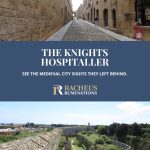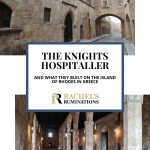In the path of the Knights Hospitaller in Rhodes
The Knights Hospitaller are perhaps less well-known than the Knights Templar, but like the Knights Templar, they were a Catholic military order born out of the chaos of the Crusades. This was the Middle Ages, a time of turmoil and religious fervor in Europe. It’s often called the Dark Ages, for good reason.
So how could a religious order also be military? The purpose of the Crusades was to take and defend the Holy Land from the so-called “infidels,” who weren’t going to leave willingly.
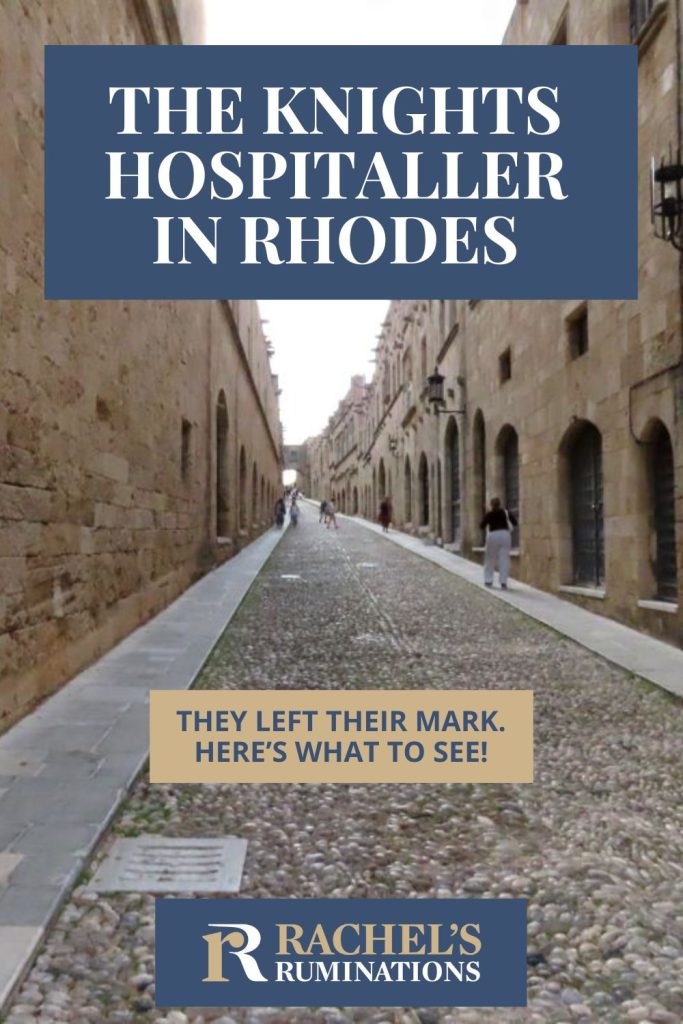
At the same time, in that period, there were plenty of men willing to fight as knights, especially if they could rationalize their plundering and pillaging by ostensibly fighting for the Lord. Generally, these knights were younger sons of European nobility. Only first-born sons inherited wealth, so there was little for younger sons to do. They could join the clergy or become knights.
Disclosure: This article contains affiliate links. Making a purchase through an affiliate link will mean a small commission for this website. This will not affect your price.
An additional disclosure: I saw one of the Hospitaller-related sights listed below as part of a sponsored walk by Guide Me in Greece. I saw another one from aboard a sponsored cruise by Sailnstay in Turkey. Neither company has any influence over what I write.
If you’re short on time, try this walking tour of Rhodes Old Town.
A brief history of the Knights Hospitaller
The Knights Hospitaller formed in the 12th century after the First Crusade (1096-1099) established what the crusaders called the Kingdom of Jerusalem. This included, besides what is now Israel and Palestine, parts of today’s Syria, Jordan, Lebanon and Turkey.
The Knights Hospitaller followed essentially the ideas of the Benedictines, who emphasized expressions of faith through acts of charity. Even before the establishment of the Kingdom of Jerusalem, Benedictines from Amalfi in Italy operated two hospitals in Jerusalem that catered to pilgrims who fell sick or got injured. They were called Hospitallers. Splitting from the Benedictines by order of the Pope in 1113, they became a separate order. Soon after, they became a military order basically by hiring knights. That’s when they took the name “Order of Knights of the Hospital of Saint John of Jerusalem” or, in short, the Knights Hospitallers.
The Knights Hospitaller helped defend the Kingdom of Jerusalem against the Mamluk forces trying to retake the territory. Ultimately, the Knights failed. The Hospitallers had to flee the Holy Land in 1291 when the last city under their control, Acre, fell. They moved first to Cyprus but only stayed a few years, eventually settling in Rhodes, ruling it starting in 1310.
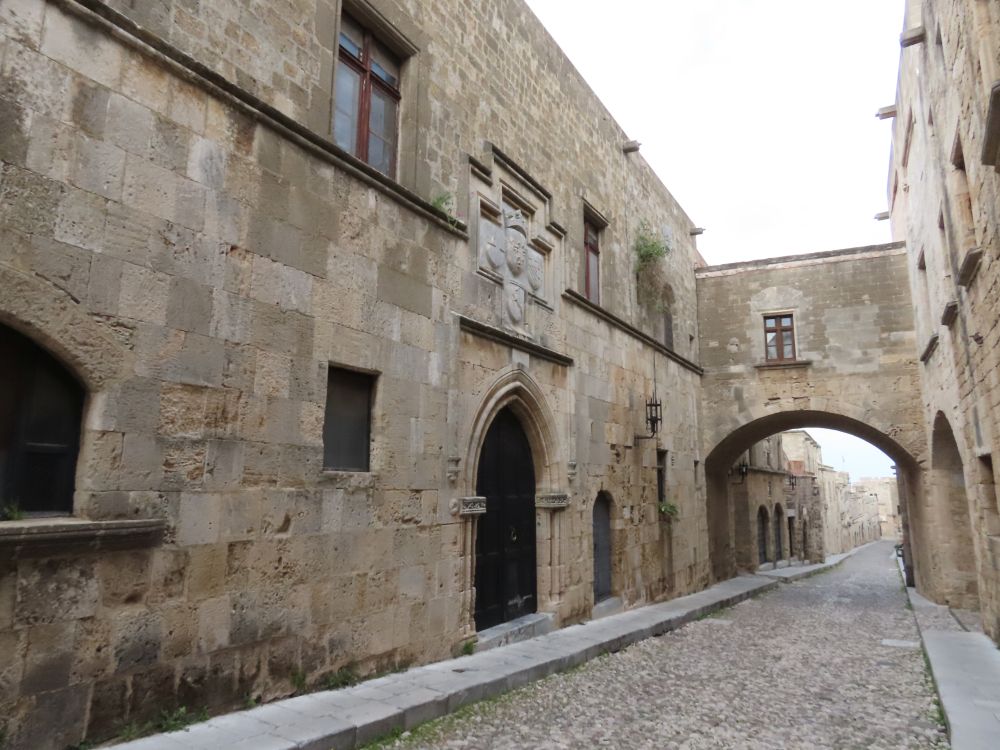
Soon after the Knights Hospitaller took over Rhodes, Pope Clement V dissolved the Knights Templar and gave their property to the Knights Hospitaller. This was a merger, in effect, and added to the power and wealth of the Knights Hospitaller in Rhodes.
For the 200+ years that the Knights Hospitaller ruled Rhodes, the city thrived on trade across the Mediterranean. It offered a convenient stopping-off point for merchant ships and for crusaders and pilgrims headed for the Holy Land.
Three times the city faced sieges: in 1444, 1480 and 1522. Twice, it withstood the siege. The third one, however, led by Suleiman the Magnificent, was what finally drove the Knights Hospitaller out of Rhodes. They fled again, this time to Malta.
The point of this historical summary is to explain how the Knights Hospitaller left so many traces of their rule everywhere they went. Besides carrying out crusades, fighting Muslims, defending pilgrims, tending to the sick and dreaming of a return to Jerusalem, they built a lot of very sturdy structures wherever they settled. Mostly they were fortresses, castles and watchtowers to defend their positions. But they also built hospitals because, after all, that was their ostensible purpose.
Many of these buildings have survived remarkably well and are now tourist destinations. This article looks at the Knights Hospitaller sites on the island of Rhodes.
Where to stay in Rhodes
But first, a word about accommodations. We stayed in a small studio very near the old city. It’s very well-equipped, and located on a pedestrian-only street. It’s just around the corner from an area of lively restaurants as well as a market and a bakery. I’d certainly recommend it if you want to have the independence of an apartment but also want to be near the sights.
Use the map below to book other accommodations on Rhodes. It’s centered on the old town, but you can just zoom out to see more of the island.
Hospitaller traces to see on the island of Rhodes
A few years ago, I had a single day on Rhodes as a stop on a Celestyal cruise. Of all the islands we visited, that was the one I knew I had to see again. The Hospitaller-built walls in particular made an immediate impression, and I wanted to experience it in more detail. So my daughter and I spent a very pleasant week recently in Rhodes’ old city – a UNESCO World Heritage site – where just wandering the streets is a delight.
Rhodes’s walls
The Knights Hospitaller ordered the construction of a number of buildings on Rhodes. The one that stands out today is the four-kilometer-long wall around the city of Rhodes. It is everything you’d wish a medieval wall to be, with its crenellated top, arched gates and round guard towers.
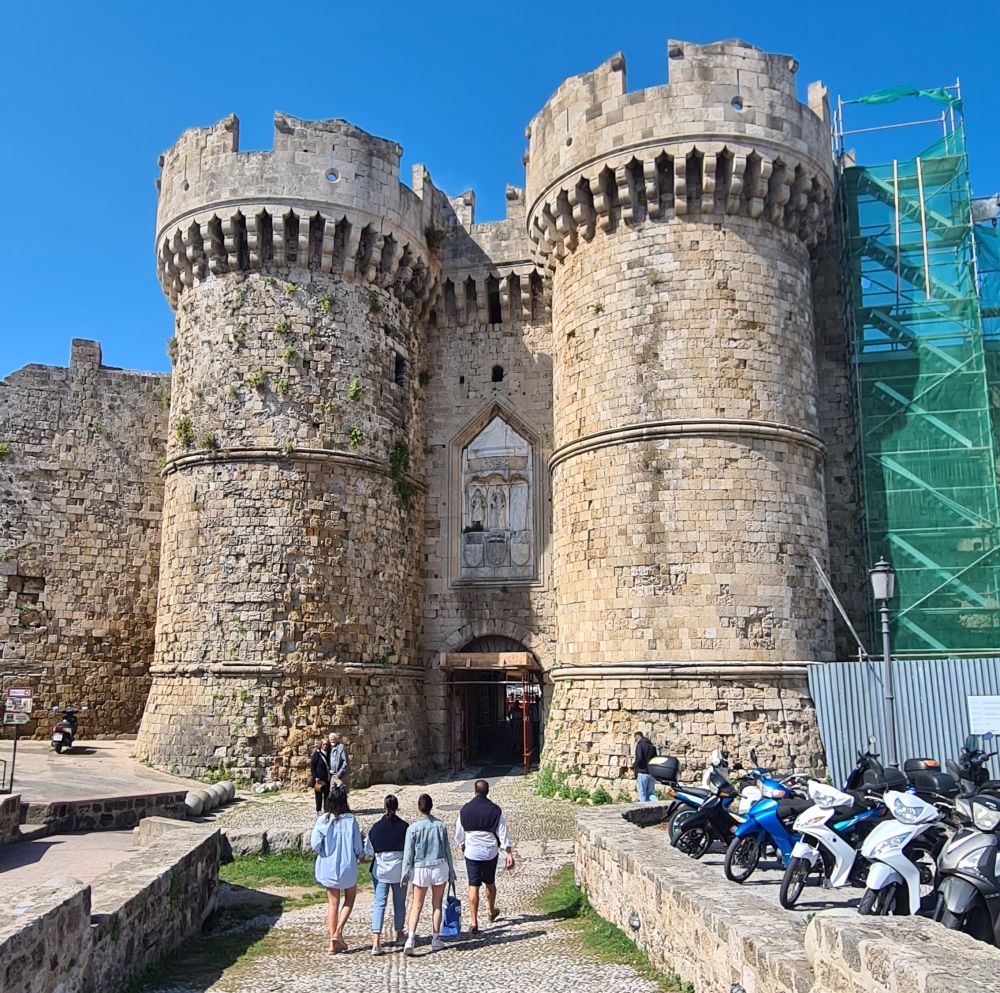
Incorporating and extending the existing Byzantine walls, the Hospitaller wall completely encircled the city. It had nine gates, which were heavily guarded. One was closed and converted to a bastion after the 1480 siege. Today there are eleven gates. Parts of the wall away from the harbor are actually an embankment rather than a wall. They are made of dirt and debris with stone sides fortifying them, topped by a walkway and crenellations and punctuated with guard towers.
Outside the wall on the land-facing side is a deep dry moat, quite wide. After the 1480 siege, additional embankments were added in the middle of the moat. Over the 200 years that the Knights controlled Rhodes, they altered the walls to reinforce them against improved technology, particularly the use of cannons.
Rhodes city walls: Free to see from the ground, both inside and outside, at any time of the day or night. To avoid crowds and get better pictures, view them early in the morning.
The city wall walk
Today, you can walk a one-kilometer section of the city walls on the landward side. The entrance is inside the palace courtyard (I’ll get to the palace later.) and once you pay the entrance fee, you cross a bridge and you’re on top of the wall or, more correctly, the embankment.
It’s a surprisingly wide embankment, and here and there along it, on the side facing outward, are guard towers – you can walk onto many of those as well. Especially from these guard towers that extend out into the moat, you can get a clear picture of the size and depth of the moat and how difficult it would be for an army to attack across it.
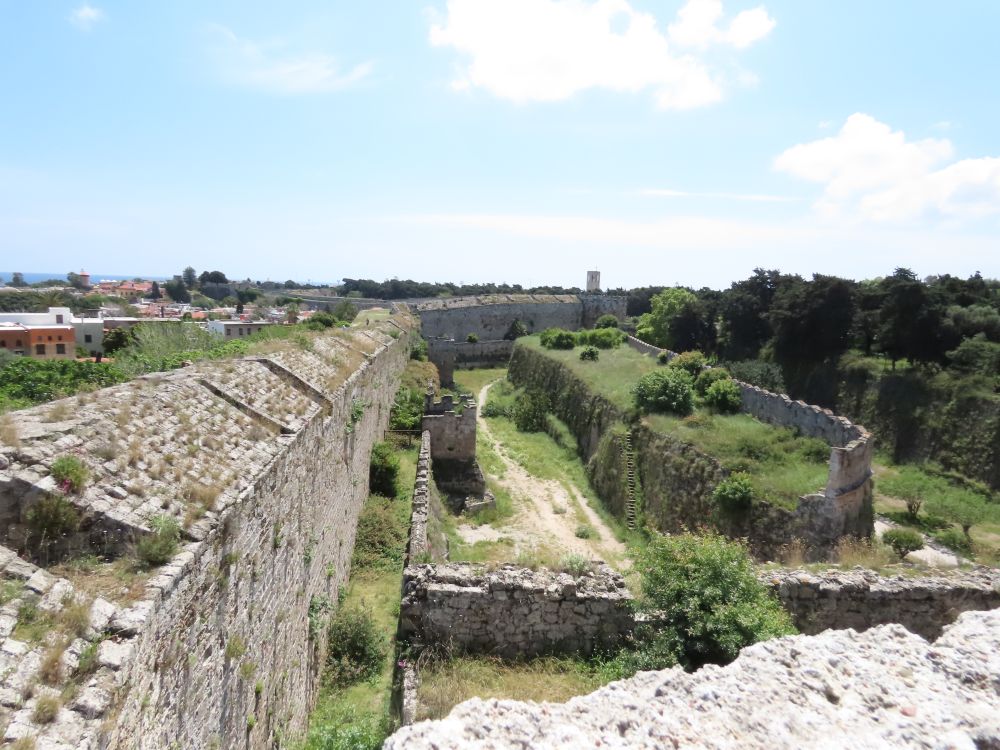
The Knights had members from many European countries who they organized into seven langues or languages. In other words, they grouped their fighting men by their region and language (France, Provence, Auvergne, Aragon, Italy, Germany, and England).
In each of the sieges, each langue defended a different section of the wall. Small informational boards point out, for each segment, which langue was assigned there in which siege and how they fared. The boards also tell about the many additions and changes over the years, naming which Grand Master of the Knights Hospitaller ordered which changes.
The moat below is also open to the public for free, if you want to save the cost of walking the walls. It’s now a park, about 2.5 kilometers (1.5 miles) long.
Wall Walk: The wall walk opened at noon when we visited in early May. Ask for the opening times at the ticket booth inside the entrance to the palace. Admission: €5. The moat seems to be open all the time.
The Knights Hospitaller hospital
The hospital that the Knights built on Rhodes was advanced for its time, or at least more comfortable than you would imagine a medieval hospital to be. The ground floor held things like stables and storage rooms and such, and the patients stayed in a huge ward upstairs. Their beds stood along the walls with curtains hung between them for privacy. Around the wall of this huge ward were smaller rooms, and I’ve heard two versions of what they were for. Our tour guide – sponsored by Guide Me in Greece – told us the little rooms were for the wealthier patients to be able to change their clothes in private. The alternative story is that they were for isolating patients with contagious diseases.

Today, the hospital is the very interesting Archaeological Museum of Rhodes and houses artifacts from all over the island, spanning centuries. In the smaller rooms on the same floor as the ward – I think they were rooms for Knights when they were patients – the objects are grouped by date and type, or by where they were found. Most are from the 800-600 BC Classical period, and the collection includes some absolutely stunning pottery – with detailed painted images – and small statues of various sorts. It’s a pretty static presentation – objects in glass cases – but they’re so pretty I didn’t really mind.
Other than the building itself, there’s not much about the Knights Hospitaller period in the museum except inside the hospital ward hall. There you’ll find a range of carved tombstones and sarcophagus covers. One interesting sarcophagus at one end of the ward shows how the Knights reused classical works; in this case it’s an ancient Greek sarcophagus standing on Knights-period stone cannonballs, with medieval carvings on the sides and an image of a knight lying on top.
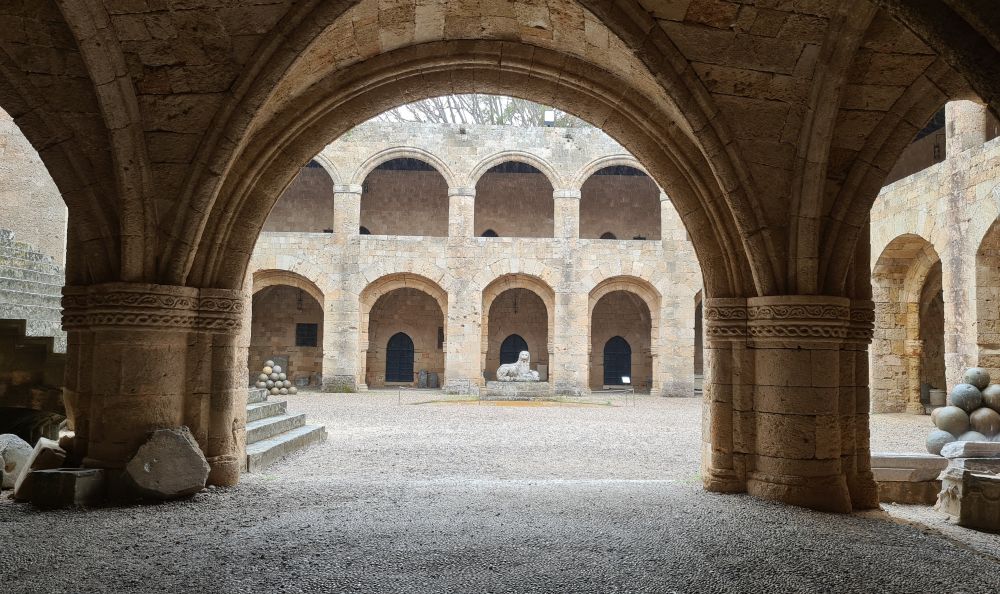
The Archaeological Museum of Rhodes: Open November-March Wednesday-Monday 8:30-15:30 and April to October daily 9:00-17:00. Admission: €10. Website.
The Street of the Knights
This street, it is claimed, is the most intact medieval street in Europe, and that’s not hard to believe. The buildings that line it were inns, each serving Knights from one of the langues. Nowadays they seem to be used by the Ministry of Archaeology, and one of them has a pretty courtyard that is open for viewing. The French consulate occupies one of them.
In any case, the street is worth a stroll. It is cobbled in the Rhodian way with smooth stones, so be careful. There is a smoother sidewalk on either side, but it’s rather narrow. Notice the coats of arms on the buildings that indicate the monarchs of the countries that each of the langues represented. Also notice the gargoyles on one of the inns.
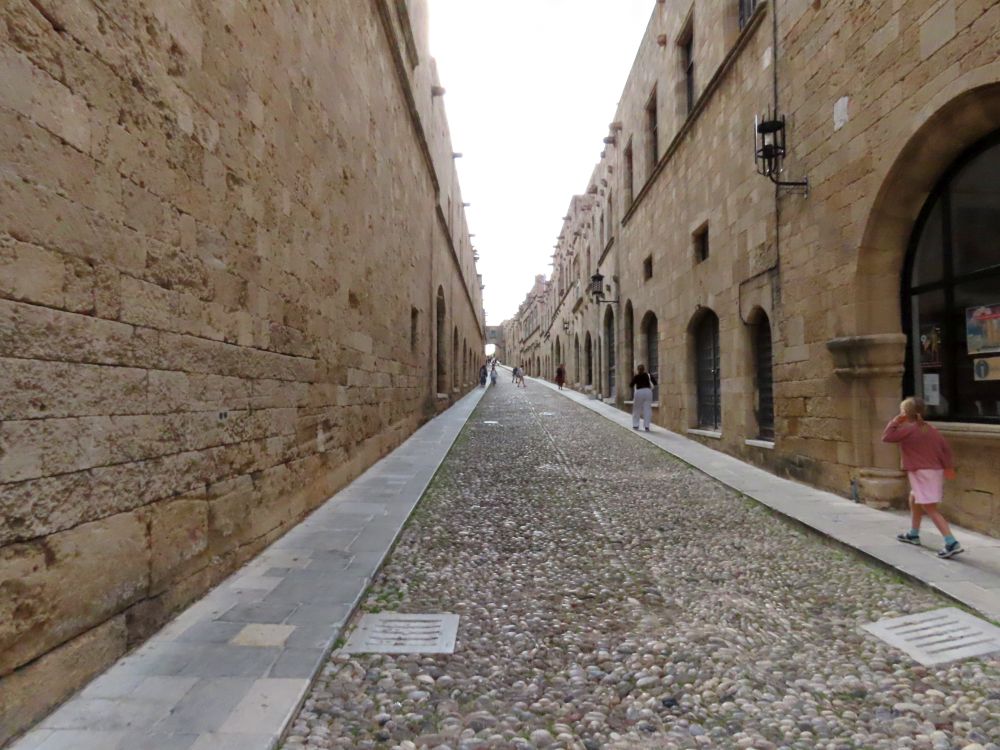
The Street of the Knights: Open day and night.
The Palace of the Grand Master of the Knights of Rhodes
This isn’t entirely what it claims to be. Set on the highest point in the city of Rhodes, the palace looks like a grand medieval castle at first glance and that is indeed what stood on the site during their rule.
The site originally held a temple to the sun god Helios, but in the 7th century a Byzantine citadel replaced it. The Knights made the citadel their headquarters and the palace of their leader, called the Grand Master, later making various changes to the structure. When the Ottomans took over in 1522, they used it as a fortress.
In 1856, stored gunpowder under a nearby church – a supply that may have been there since the Knights left in 1522 – exploded when it was struck by lightning. The explosion destroyed the palace, collapsing the upper stories, though the ground floor survived.
The palace stood in ruins until the 1930s, when the Italian government ordered its rebuilding. The new design, while still carrying the ambiance of a medieval palace, did not really respect its original design. It became a vacation residence for the King of Italy and then later for Benito Mussolini. Neither ever actually stayed there.
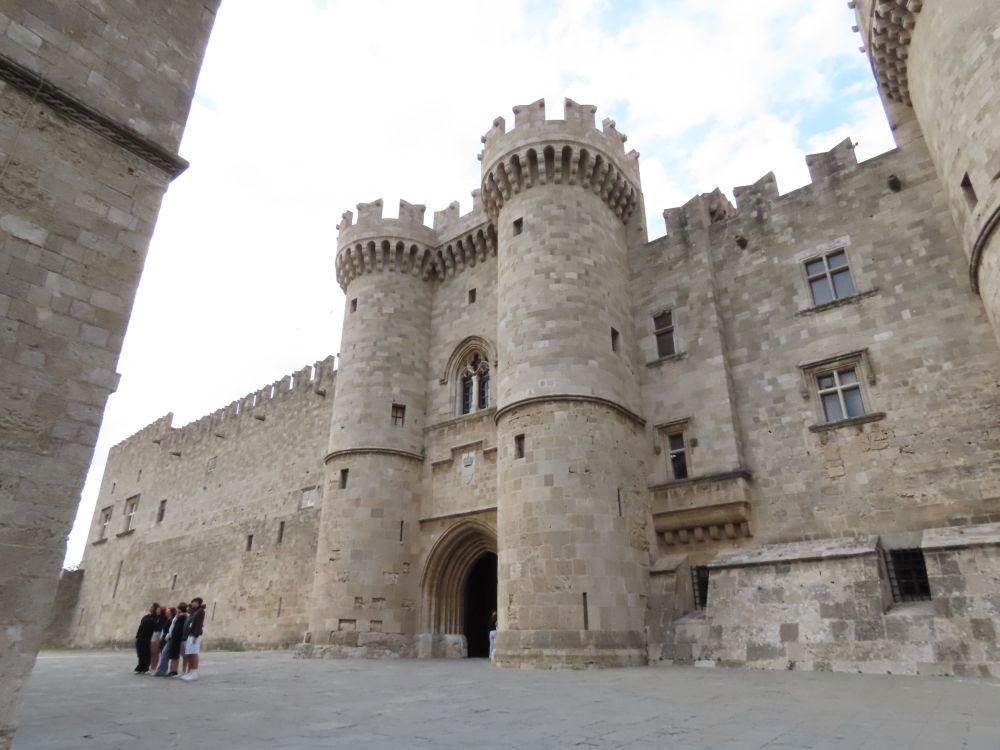
When they built this palace for the King and/or Mussolini, they had to make it as grand as possible, and one of the things they did was, essentially, strip the nearby island of Kos of many of its best artifacts. Mostly these are floor mosaics from ancient homes and palaces. They are embedded into the floors of the palace, surrounded by smooth marble of various types. These are some of the best and most intact ancient mosaics I’ve ever seen.
We learned about the history of the palace as part of a sponsored tour by Guide Me in Greece, and our tour guide was very helpful in explaining the ins and outs of this much-altered building with its beautiful stolen mosaics.
Nevertheless, if you have to skip something as you follow the path of the Knights Hospitaller, this is the thing to skip. If you have the time, however, the palace may still be worth your while, if only for those wonderful mosaics.
The fee for the palace rooms and for the wall walk are separate, so, if mosaics don’t interest you, just go to the palace’s ticket booth and ask for the wall tickets only. The entrance is outside the palace’s courtyard, so you buy the ticket and then exit again.

Palace of the Grand Master: Open November-March Wednesday-Monday 8:30-15:30 and April to October daily 8:00-20:00. Admission: €20. Website.
Other locations on Rhodes
The Knights Hospitaller ruled the whole island of Rhodes, but only fortified – or rather, refortified – Rhodes city. However, at Lindos there is an ancient Greek acropolis: a fortress and tower on a high hill. The Knights added to that acropolis a bit. Some walls and a small building still stand on the edges, but the center of attention is still the Greek temple.
There are other structures on the island built by the Knights. All are in a rather advanced stage of ruin, but they all offer wonderful views over land and sea, and they are free to visit. They used them to help defend the island from invasion by the Ottomans. Here I’ve listed them north to south, moving down the west coast from Rhodes city:
- Kritinia Castle, above the village of Kritinia
- Kymisala Tower, on a bay quite remote from any town. Only accessible by hiking trails. On a boat trip you could see it at a distance.
- Monolithos Castle, above Monolithos town
Traces of the Knights Hospitaller elsewhere
While my focus here has been Rhodes, there are other places to see Knights-Hospitaller-related sights. The ones I’ve visited are in Israel:
Belvoir Fortress
Belvoir Fortress, south of the Sea of Galilee, offers a classic image: a square fortress with absolutely massive walls, corner guard towers and a deep dry moat, perched on a steep hill. Despite its seeming invulnerability, the forces of General Saladin forced the Knights to surrender the fort in 1189. You can read more about visiting Belvoir Fortress in my earlier article.
Akko (Acre)
Once it was conquered in the First Crusade in 1104, Akko became the main port for crusaders and pilgrims arriving in the Holy Land on their way to Jerusalem. Saladin briefly reclaimed it, but then new crusaders, led by Richard the Lionhearted, recaptured it in 1191. This time the Knights held the city until the Mamluk defeat of the Kingdom of Jerusalem in 1291.
Akko is home to a fortress built by the Knights Hospitaller. Later, the Ottomans built a citadel on top of it. Today, the underlying fortress has been excavated but the citadel still sits on top, which means the very atmospheric fortress that tourists can visit is now underground.
A 350-meter-long tunnel (1,148 feet) links the port, where the pilgrims arrived, to the fortress. Today it is open as well for tourists.
You can read more about Akko and other things to see there in my earlier article.
There are quite a few other sites where the Knights Hospitaller left their mark: in Israel, but also in Malta (where they ruled from 1530-1798, building what is now Malta’s capital city, Valleta), Syria, Lebanon, Turkey, Greece (including several Dodecanese islands besides Rhodes), and Cyprus. In mainland Europe, there are various churches, fortresses and hospitals in France, Italy, Spain, Portugal, Austria, Switzerland, Poland, Germany, Scotland, and England. See the full list on Wikipedia.
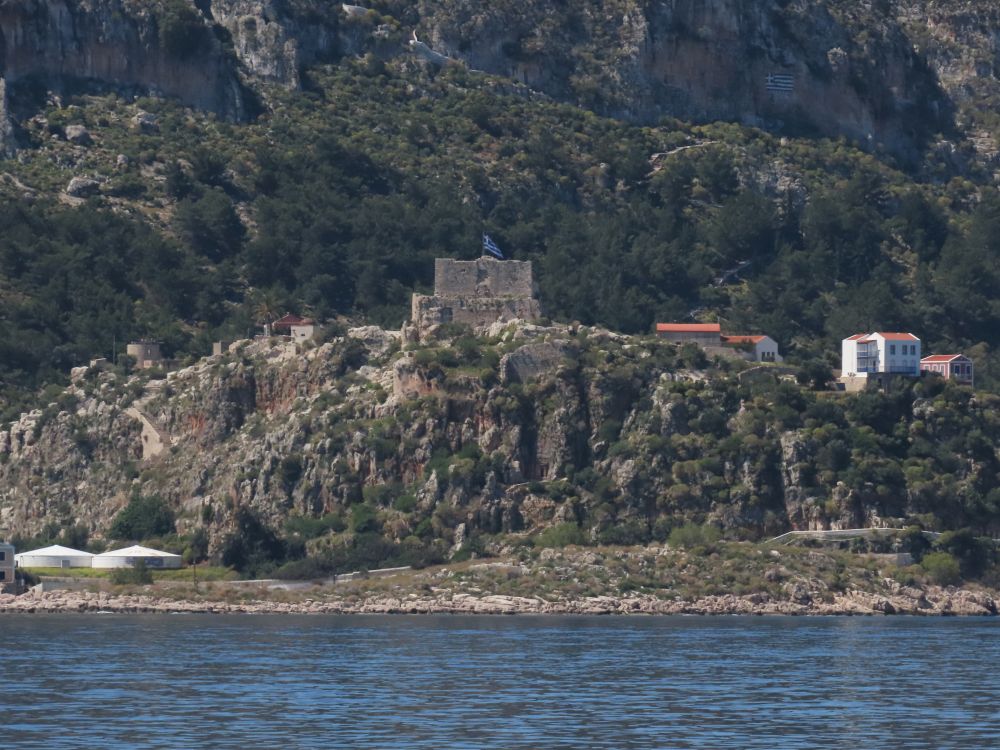
Have you been to the island of Rhodes or any of the other Knights Hospitaller sites? Add a comment below!
My travel recommendations
Planning travel
- Skyscanner is where I always start my flight searches.
- Booking.com is the company I use most for finding accommodations. If you prefer, Expedia offers more or less the same.
- Discover Cars offers an easy way to compare prices from all of the major car-rental companies in one place.
- Use Viator or GetYourGuide to find walking tours, day tours, airport pickups, city cards, tickets and whatever else you need at your destination.
- Bookmundi is great when you’re looking for a longer tour of a few days to a few weeks, private or with a group, pretty much anywhere in the world. Lots of different tour companies list their tours here, so you can comparison shop.
- GetTransfer is the place to book your airport-to-hotel transfers (and vice-versa). It’s so reassuring to have this all set up and paid for ahead of time, rather than having to make decisions after a long, tiring flight!
- Buy a GoCity Pass when you’re planning to do a lot of sightseeing on a city trip. It can save you a lot on admissions to museums and other attractions in big cities like New York and Amsterdam.
Other travel-related items
- It’s really awkward to have to rely on WIFI when you travel overseas. I’ve tried several e-sim cards, and GigSky’s e-sim was the one that was easiest to activate and use. You buy it through their app and activate it when you need it. Use the code RACHEL10 to get a 10% discount!
- Another option I just recently tried for the first time is a portable wifi modem by WifiCandy. It supports up to 8 devices and you just carry it along in your pocket or bag! If you’re traveling with a family or group, it might end up cheaper to use than an e-sim. Use the code RACHELSRUMINATIONS for a 10% discount.
- I’m a fan of SCOTTeVEST’s jackets and vests because when I wear one, I don’t have to carry a handbag. I feel like all my stuff is safer when I travel because it’s in inside pockets close to my body.
- I use ExpressVPN on my phone and laptop when I travel. It keeps me safe from hackers when I use public or hotel wifi.



